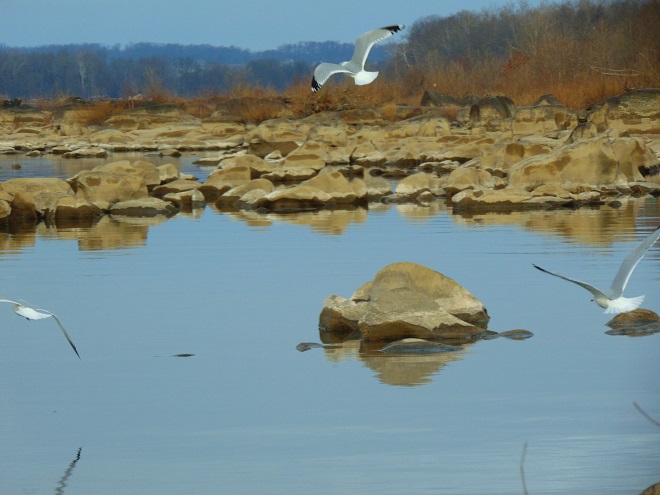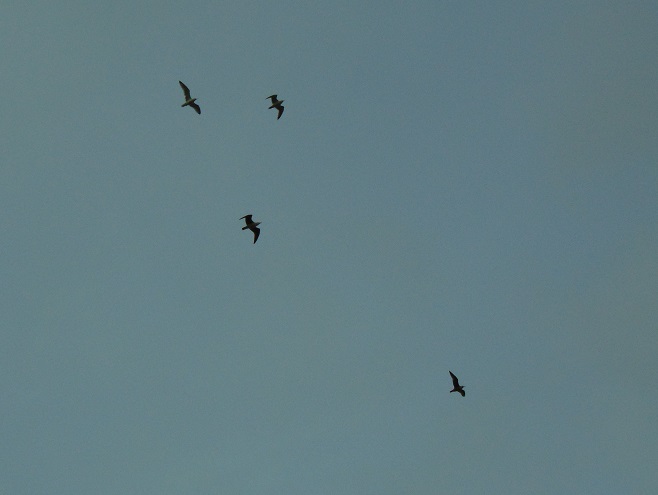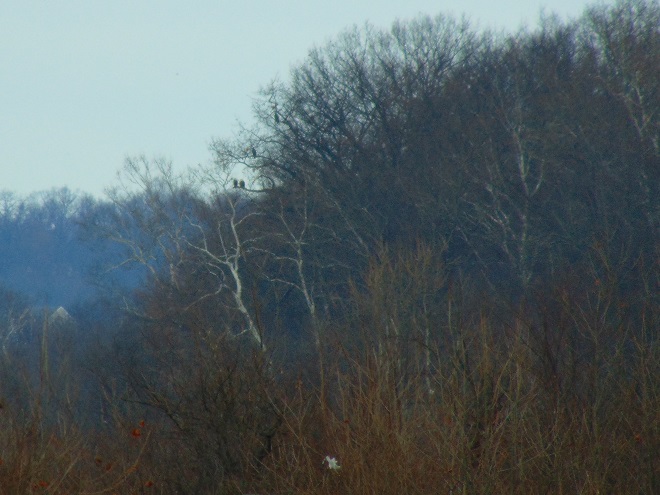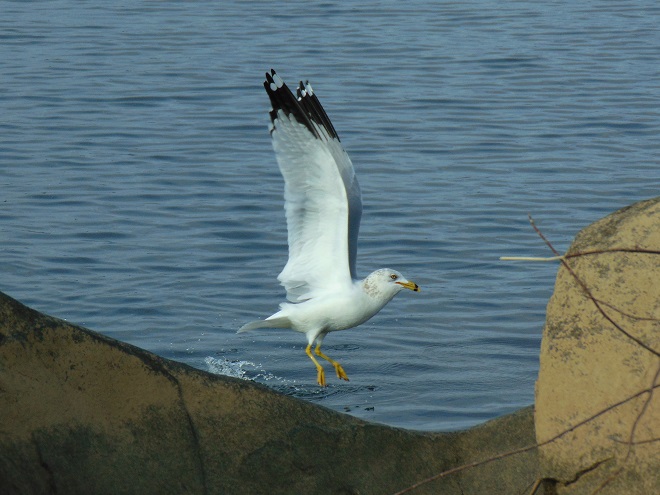
A steady stream of birds was on the move this morning over Conewago Falls. There were hundreds of Ring-billed Gulls, scores of Herring Gulls, and a few Great Black-backed Gulls to dominate the flight. Then too there were thirteen Mallards, Turkey Vultures and a Black Vulture, twenty or more American Robins, a half a dozen Bald Eagles (juvenile and immature birds), a couple of Red-winged Blackbirds, and, perhaps most unusual of all, a flock of a dozen Scoters (Melanitta species), a waterfowl typical of the Mid-Atlantic surf in winter. All of these birds were diligently following the river, and into a headwind no less.
“Hold on just a minute there, buster,” you may say, “I’ve looked at the migration count by dutifully clicking on the logo above and there is nothing but zeroes on the count sheet for today. The season totals have not changed since the previous count day!”
Ah-ha, my dedicated friend, correct you are. It seems that today’s bird flight was solely in one direction. And that direction was upriver, moving north into a north breeze, on a heading which conflicts with all logic for creatures that should still be headed south for winter. As a result, none of the birds observed today were counted on the “Autumn Migration Count”.
You might say, “Don’t you know that Winter Solstice was three days ago, so autumn and autumn migration is over.”
Okay, point well taken. I should therefore clarify that what we title as “Autumn Migration Count” is more accurately a census of birds, insects, and other creatures transiting from northerly latitudes to more favorable latitudes to the south for winter. This transit can begin as early as late June and extend into the first weeks of winter. While most of this movement is motivated by the reduced hours of daylight during the period, late season migrants are often responding to ice, bad weather, or lack of food to prompt a journey further south. Migration south in late December and January occurs even while the amount of daylight is increasing slightly in the days following the Winter Solstice.
So what of the birds seen flying north today? There was some snow cover that has melted away, and the ice that formed on the river a week ago is gone due to the milder than normal temperatures this week.
One may ask, “Were the birds seen today migrating north?”
Let’s look at the species seen moving upriver today a try to determine their motivation.
First, and perhaps most straight-forward, is the huge flight of gulls. Wintering gulls on the Susquehanna River near Conewago Falls tend to spend their nights in flocks on the water or on treeless islands and rocky outcrops in the river. Many hundreds, sometimes thousands, find such favorable sites along the fifteen mile stretch of river from Conewago Falls downstream to Lake Clarke and the Conejohela Flats at Washington Boro. Each morning most of these gulls venture out to suburbia, farmland, landfill, hydroelectric dams, and other sections of river in search of food. Gulls are very able fliers and easily cover dozens of miles outbound and inbound each day in search of food. Many of the gulls seen this morning were probably on their way to the Harrisburg metropolitan area to eat trash. Barring any extraordinary buildups of ice on this section of river, one would expect these gulls to remain and make these daily excursions to food sources through early spring.


Second, throughout the season Bald Eagles have been tallied on the migration count with caution. Flight altitude, behavior, plumage, and the reaction of the “local” eagles to these transients was carefully considered before counting an eagle as a migrant. They roam a lot, particularly when young, and range widely to feed. The movement of eagles up the river today was probably food related. A gathering of adult, juvenile, and immature Bald Eagles could be seen more than a half mile upstream from the migration count lookout. Those moving up the river seemed to assemble with the “locals” there throughout the morning. White-tailed Deities occasionally drown, particularly when there is thin or unstable ice on the river (as there was last week) and they attempt to tread upon it. Then, their bodies are often stranded among rocks, in trees, or on the crown of the dam. After such a mishap, their carcasses become meals for carrion-eaters in the falls. Such an unfortunate deity, or another source of food, may have been attracting the eagles in numbers today.

Next, Black and Turkey Vultures often roam widely in search of food. The small numbers seen headed up-river today would tend to mean very little when trying to determine if there is a trend or population shift. Again, food may have been luring them upriver from nearby roosts.
And finally, the scoters, Mallards, American Robins, and Red-winged Blackbirds may have been wandering as well. Toward mid-day, the wind speed picked up and the direction changed to the east. This raises the possibility that these and others of the birds seen today may sense a change in weather, and may seek to take flight from the inclement conditions. Prompted by the ocean breeze and in an attempt to avoid a storm, was there some movement away from the Atlantic Coastal Plain to the upper Piedmont today? Many species may make these types of reactive movements. Is it possible that some birds flee or avoid ever-changing storm tracks and alter there wintering locations based on jet streams, water currents, and other climatic conditions? Probably. These are interesting dynamics and something worthy of study outside the simpler methods of a migration count.

